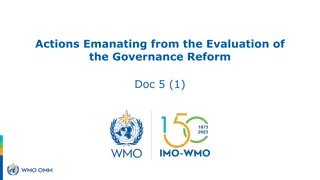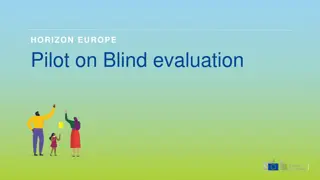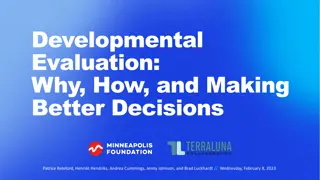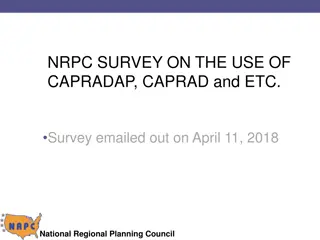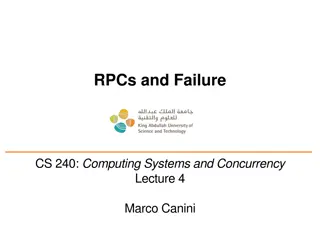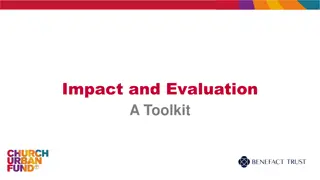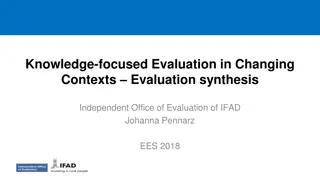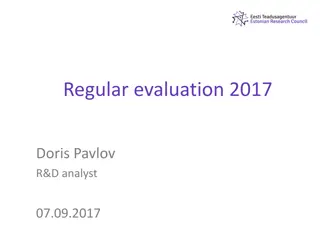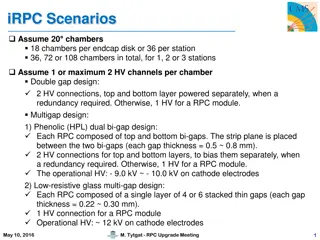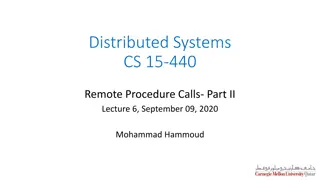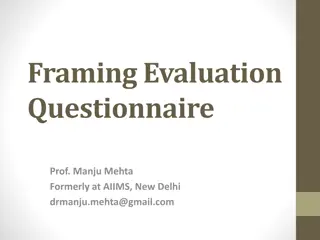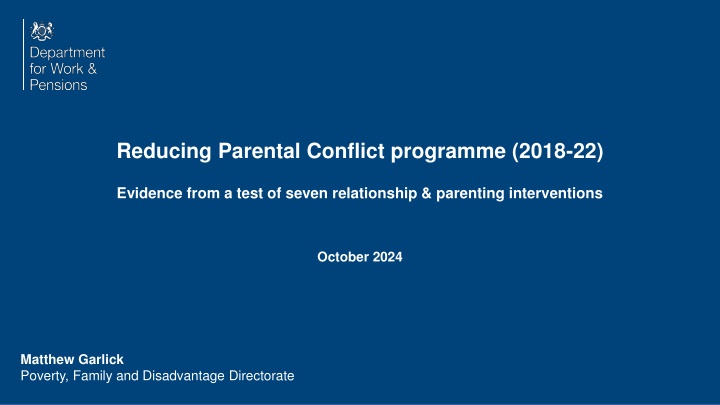
Impact of Reducing Parental Conflict Programme (2018-22)
Explore the evidence and results from a test of seven relationship and parenting interventions as part of the Reducing Parental Conflict Programme (2018-22). Discover the programme and evaluation design, main results, high-level findings, diary research with parents, and the evaluation design. Gain insights into the integration of RPC into local family services, testing of interventions, external evaluation, and parents' experiences. Delve into the in-house analyses of intervention effects, correlations between improved relationships and child wellbeing, and more between 2019 and 2022.
Download Presentation

Please find below an Image/Link to download the presentation.
The content on the website is provided AS IS for your information and personal use only. It may not be sold, licensed, or shared on other websites without obtaining consent from the author. If you encounter any issues during the download, it is possible that the publisher has removed the file from their server.
You are allowed to download the files provided on this website for personal or commercial use, subject to the condition that they are used lawfully. All files are the property of their respective owners.
The content on the website is provided AS IS for your information and personal use only. It may not be sold, licensed, or shared on other websites without obtaining consent from the author.
E N D
Presentation Transcript
Reducing Parental Conflict programme (2018-22) Evidence from a test of seven relationship & parenting interventions October 2024 Matthew Garlick Poverty, Family and Disadvantage Directorate
Content 1) Programme and evaluation design 2) Results from the interventions test Background on the interventions and evaluation method Main results in terms of the effect of the interventions on interparental relationships Main results in terms of the effect of the interventions on child behaviour and wellbeing Very high-level findings from the commissioned research (from our research contractor, IFF Research) 3) An outline of findings from the diary research with parents (from the DWP in-house Research Unit) 4) 2
Reducing Parental Conflict (2018-22) evaluation design In-house analyses of the effects of 7 different relationship and parenting interventions on parental conflict and child wellbeing, exploring: which of the 7 interventions worked best (very few relationship/conflict interventions have been tested in the UK with low-income/disadvantage families) whether improvements were sustained for 12 months correlations between improved interparental relationships and better child wellbeing/mental health whether certain family groups (e.g. separated/intact, working/workless and white/non-white) benefited more/less Integrating RPC into local area family services Testing 7 Interventions for parents in conflict External evaluation (by IFF Research Ltd) exploring: Integration the extent to which the RPC practice & service organisation are embedded into local area family services Training the process of building the RPC capability of family practitioners and other professionals to allow them to identify parental conflict and deliver support to reduce it Interventions parents experiences and perceived impacts of 7 different relationship and parenting interventions, tested in 31 local authorities between 2019 and 2022 Diary research with parents on interventions: Innovative research conducted by the DWP In-house Research Unit exploring the day-to-day experiences of 45 parents as they participated in RPC interventions Providing detailed insight into how the support parents received affected relationships and family life 3
Context how the interventions tests were designed Between 2019 and 2022 the Reducing Parental Conflict programme tested 7 different interventions through three providers, across 31 upper tier local authorities in 4 contract package areas (CPAs) to help families in conflict. The interventions tested: Mentalization Based Therapy Level 5 Family Transitions Triple P The Incredible Years Advanced Level 5 Enhanced Triple P Family Check-up Parenting When Separated Programme Within My Reach 4 Rs and 2Ss (no referrals, so not tested) Four CPAs: Dorset, Gateshead, Hertfordshire, and Westminster Three providers: Relate, Tavistock Relationships and Twin Training 4
We measured parental conflict and child mental health before and after participation to estimate the effectiveness of the interventions Questionnaires asked: 1) Before intervention 2) After intervention 3) 6mths after 4) 12mths after Parental relationships & child mental health Parental relationships & child mental health Parental relationships Intervention Questionnaire focus: Basic evaluation design Parents were asked questions on various aspects of their relationship with the other parent, and one child s mental health, once before and at three points after intervention Questions were selected from academically established measures of interparental relationships and child mental health Separated parents have different relationship issues to intact parents, therefore different measures were used for each parent group Average scores for groups of questions were calculated at each point in time and compared to determine the extent to which relationships and child mental health had improved The analysis included calculating an effect size to allow us to compare the size of all improvements 5
Some of the questions we asked Considering the last 4 weeks Intact parents Separated parents How often was your partner loving and affectionate toward you? (Always- -Never) How often was the atmosphere one of hostility and anger? (Always- -Never) Nature of conflict Warmth How often did your partner shout at you? (Always- -Never) Frequency of conflict Hostility How often did you argue? (Always- -Never) Breadth of conflict Did you argue about? (Money/Parenting/Chores/Drinking ) How often did you discuss or had considered divorce, separation? (All the time- -Never) Relationship satisfaction Co-parenting support How often was your former partner helpful in raising your children? (Always- -Never) Overt hostility How often did you argue in front of the child? (All the time- -Never) How satisfied were you with arrangements for your child custody (who your child lives with) ? (Very Dissatisfied- -Very Satisfied) Satisfaction with custody
Measuring the effect size of the interventions Cohens d The Cohen s d is a commonly used measure of the effect size of a treatment or intervention As each intervention tested attracted different numbers of families and some subscales are scored differently, the Cohen s d makes it possible to compare the effect sizes across each subscale and intervention Otherwise it s like trying to compare lightweight and heavyweight boxers Using the Cohen s d also allows us to compare our results with other studies of different sizes Cohen s d value has a theoretical range 0 - Effect Size Small Medium Large Cohen's d 0.2 0.5 0.8 or greater 7
Overall impacts for separated parents: Improvements were observed across the full range of relationship measures Key observations: Medium-large reductions in conflict when communicating, and the frequency and breadth of conflict. Small-medium sized improvements in co- parenting support and satisfaction with custody arrangements. Improvements were sustained for at least 12 months for all subscales. Breadth of conflict and frequency of conflict showed statistically significant improvements 6 months after completing an intervention. The co-parenting support and satisfaction with custody arrangements subscales are less sensitive to change, partly because they require a change in the behaviour of the other parent. Co-parenting support These results represent the average effects of all six of the interventions being tested on separated parents 8
Overall impacts for intact parents: Improvements were observed across the full range of measures for intact parents Key observations: Medium-large improvements were observed across all four subscales. The effect sizes suggest slightly larger impacts for intact couples compared with separated parents. The reductions in conflict were sustained for at least 12 months for all subscales Reasons for intact couples reporting larger improvements: Less likely to participate alone Different relationship measures Different interventions available These results represent the average effects of all five of the interventions being tested for intact parents 9
Some of the questions we asked parents about their child The evaluation uses the Strengths and Difficulties Questionnaire, a well-established psychometric tool for assessing children s mental health. Parents are asked to consider their youngest child or the child whose behaviour they are most concerned about. 5-17 year olds 2-4 year olds My child is often unhappy or downhearted My child is often unhappy or downhearted Emotional problems Often lies or cheats Steals from home, school or elsewhere Can be spiteful to others Often argumentative with adults Conduct problems Thinks things out before acting Can stop and think things out before acting Hyperactivity My child is rather solitary, tends to play alone Peer problems My child is rather solitary, tends to play alone My child is considerate of other people's feelings My child is considerate of other people's feelings Prosocial behaviour Answer options: Not True Somewhat True Certainly True
Overall impacts: Significant improvements detected across all measures used for children aged 5-17 Key observations: For all subscales, improvements are significant at the 1% level medium reductions of emotional and conduct problems, as well as total difficulties scores Small reductions of hyperactivity, peer problems and (lack of) prosocial behaviours Improvements were sustained for up to 12 months after the intervention was completed Higher than average SDQ scores Notes: Analysis was based on responses from 350 families who answered all questions of both an IAQ (before) and FUQ6 (6 months after an intervention). Of the 350, 135 families answered all questions of both an IAQ and an FUQ12 (12 months after an intervention). Effect sizes relate to the improvements between the before intervention period, and the first after intervention period. Comparison to the average SDQ score, reported by parents, in Britain. (Meltzer, Gatward, Goodman., and Ford, 2000) High SDQ scores typically improve with time even when children receive no assessment or intervention, partly as a result of regression to the mean.
Summary: Different families and interventions different effects The interventions worked quantitative analyses show that they reduced interparental conflict and improved the mental health of the children in participating families Sample sizes were sufficient to support intervention level analyses for six interventions; all six interventions showed improvements in both interparental relationships and child wellbeing. Families that completed more expensive, high intensity, interventions showed greater improvements in both interparental relationships and child mental health than families that completed moderate intensity interventions. When both parents participated, greater improvements were demonstrated in interparental relationships and child wellbeing, though parents participating without the cooperation of the other parent still showed statistically significant improvements. Both workless and working families showed similar improvements in interparental relationships, but families where both parents work saw greater improvements in child wellbeing. 12
Key parent related findings from the commissioned evaluation Due to the pandemic, 80% of parents took part at home digitally, which was perceived to work well and gave many parents more flexibility to participate. Some parents preferred face-to-face support, at home or a venue. A small minority of parents got the impression that participation was mandatory, when this type of support is designed to be voluntary. Thinking that the support was mandatory did not help retention/completion. Most parents who completed an intervention reported positive outcomes. Relationship improvements were more likely where both parents within a couple participated. Sometimes, non-participation of the other parent led the remaining parent to disengage. Some parents who did not complete interventions still reflected positively on the sessions they attended. Where the impact of support was high, parents could better understand where their (ex) partner was coming from during disagreements, and couples (intact only) were more able to manage tense situations through better communication. A few parents who felt there had been limited impact on their relationship still felt they had taken some personal benefits from the sessions, including improved confidence and mental health. Parents who felt the sessions had improved the relationship with their (ex) partner were more likely to report that their children were less anxious and happier following the sessions. 13
Key findings by parent type Continue to offer support to CMS users CMS users were initially less likely to perceive a positive impact on their relationship and their children 6 months after completing an intervention, however, after another 6 months, the proportion who had seen these positive impacts was in line with other parents. CMS users had higher levels of conflict so were arguably one of the groups in greatest need of support. Continue to engage both intact and separated parents Intact parents tended to be more positive and receptive to the interventions, however, there were still significant improvements on relationships and children s behaviour for separated parents. Where parents are separated, it may be more difficult to engage both parents, but there is clear benefit to doing so. Continue to offer support to fathers Fathers were initially more hesitant about the potential benefits of participating in interventions but then often found it useful to hear from other parents in comparable situations, and fathers specifically. Consistent with other key learning, engaging fathers is important because they also benefit from intervention. The most positive results are delivered when both parents are engaged. Ensure that a range of support is available Future RPC support should seek to engage and include a wide range of families. Some specialist provision should be available for families with specific challenges that might not be met by more generic services. 14
Diary research design Longitudinal research with 45 parents as they participated in one of the 7 interventions tested Referral During the intervention On completion Diary entries collected on a smartphone app (sometimes prompted by DWP researchers) Final telephone interview with a DWP researcher An initial telephone interview with a DWP researcher 15
The diary research provides detailed insight into how the support parents received affected relationships and family life Most research participants reported benefits and positive outcomes, for example, in communication and/or warmth and understanding, some from an early stage. Sometimes, the nature of conflict meant that support was most helpful where it focused on coping mechanisms and emotional regulation (esp. separated parents). Manyfactors affected outcomes and engagement, including the nature of the parental relationship (intact or separated) and parents background and beliefs. Participation was hindered when parents felt their support needs were more complex than interventions were able to provide. Support was helpful when it related specifically to the experiences of participants. Parents disengaged with interventions when they were not tailored to their circumstances and did not adapt when circumstances changed. 16
Evaluation reports from the 2018-22 RPC programme Reports focusing on how RPC was being integrated into local service (inc. training): RPC programme evaluation: report on early implementation (based on research conducted from the first 9 months of the programme) RPC programme evaluation: second report on implementation(focused on research conducted between December 2019 and January 2021) Reports focusing on the interventions that we tested: RPC programme evaluation: Third report on implementation(based on research conducted between January 2021 and December 2021) RPC programme 2018 to 2022: An evaluation of the effects of interventions on parental relationships and children(covers the quantitative results from our test of seven RPC interventions) RPC programme 2018 to 2022: Final evaluation report (a final report from the commissioned evaluation of the 2018 to 2022 programme, drawing on quantitative surveys with parents that ran between summer 2020 and summer 2022, as well as final qualitative research conducted with local authorities in 2022) RPC programme 2018 to 2022: Diary research with parents accessing interventions (covering longitudinal diary research conducted with parents as they participated in the interventions we tested)
Interventions included in the in-house evaluation Key details: Sufficient sample for conflict reduction tests Sufficient sample for sustained conflict tests High or moderate intensity Seven interventions were tested but too few families completed Incredible Years to support robust analysis Intact or separated Intervention Interventions tested were either moderate or high intensity, and some were aimed at either intact or separated couples, or both Mentalization Based Therapy Level 5 Family Transitions Triple P The Incredible Years including Advanced Programme Both High Separated High High and moderate intensity interventions have been grouped to give insight on whether more expensive interventions yield a larger reduction in conflict Both High Level 5 Enhanced Triple P Intact High Family Check-up Parenting When Separated Programme Intact Moderate 1,685 families completed an intervention Separated Moderate MBT received the most referrals, with a third of completers attending MBT interventions Within My Reach Both Moderate
Interventions included in the in-house evaluation Key details: Eight interventions were tested (MBT, FT-TP, ETP, PWS, IY Advanced, WMR, FCU and 4Rs, 2Ss) Sufficient sample for sustained 5-17 yo tests High or moderate intensity Sufficient sample for 2- 4 yo tests Intact or separated Intervention but 4Rs, 2Ss did not receive any referrals and too few families completed Incredible Years to support robust analysis Some of these interventions were for intact couples, some for separated parents and others were for both family types Both High Mentalization Based Therapy Level 5 Family Transitions Triple P The Incredible Years including Advanced Programme Separated High Interventions were rated as either moderate or high intensity Both High High/moderate intensity interventions compared to establish whether more expensive interventions delivered better outcomes (MBT and FTTP were high intensity; PWS moderate intensity) Intact High Level 5 Enhanced Triple P Intact Moderate Family Check-up Parenting When Separated Programme Separated Moderate Questions asked about 2-4 and 5-17 year olds differed slightly Both Moderate Within My Reach 1,685 families completed one of these interventions Mentalization Based Therapy received the most referrals, with a third of completers attending MBT
Key statistics Key subgroup statistics (family level) Key subgroup statistics (parent level) All Participated together Participated alone All Participated together Participated alone Separated Intact Separated Intact parents 3,810 3,000 1,690 parents 2,330 1,800 1,020 1,490 1,200 670 2,580 2,050 1,120 1,240 950 570 Referred Started Completed 6,110 4,800 2,690 3,520 2,690 1,520 2,590 2,120 1,180 4,870 3,850 2,120 1,240 950 570 Referred Started Completed Contract Package Area statistics (parent level) Number of parents that were referred to, started, and completed an intervention, broken down by CPA: Contract Package Area statistics (family level) Number of parents that were referred to, started, and completed an intervention, broken down by CPA: Stage All Westminster Gateshead Hertfordshire Dorset Stage All Westminster Gateshead Herts Dorset 6,110 4,800 2,690 850 720 560 1,800 1,360 570 1,670 1,310 920 1,740 1,410 640 3,810 3,000 1,690 590 500 400 940 710 290 1,080 850 600 1,170 940 410 Referrals Starts Completers Referrals Starts Completers
Intensity level impacts: High intensity interventions outperformed moderate intensity interventions across 5 of the 6 subscales Effect Size Small Medium Large Cohen's d 0.2 0.5 0.8 or greater Separated parents Key observations: High intensity interventions result in a larger reduction in conflict than moderate interventions, on average. Initial conflict reduction from high intensity interventions is significant at the 1% level for all subscales. Initial conflict reduction from moderate intensity interventions is significant at the 1% level for all measures aside from satisfaction with custody arrangements. As mentioned previously, this is because satisfaction with custody arrangements is not as sensitive to change. For both intensities, this reduction is sustained for at least 12 months following intervention. For both intensity levels, some subscales show statistically significant improvements in the 6 months following an intervention. 22
Intensity level impacts: High intensity interventions outperformed moderate intensity interventions across the full range of subscales Effect Size Small Medium Large Cohen's d 0.2 0.5 0.8 or greater Intact parents Key observations: High intensity interventions result in a larger reduction in conflict than moderate interventions Initial conflict reduction following both high and moderate intensity interventions is significant at the 1% level for all subscales This reduction is sustained for at least 12 months following intervention for all subscales High intensity interventions are expected to show larger effects. They are more expensive and typically consist of a greater number of sessions. This evaluation does not account for this 23
The children of intact parents generally experienced greater improvements in wellbeing (5-17 year olds) Key observations: Medium-large reductions of emotional and conduct problems, as well as total difficulties, for children with intact parents. Small reductions in all other measures. Medium reductions in emotional problems and total difficulties for children with separated parents. Small reductions in all other measures. On average, children with intact parents experienced greater improvements in wellbeing than those with separated parents. This is in line with findings for conflict levels between parents. Reduction in total difficulties is significant at the 1% level for children of both family types. For separated parents, this is sustained for up to 12 months following intervention. There are too few intact parents in the sample to carry out analysis of the 12 month follow up survey. Notes: Based on 239 children of intact parents, and 111 children of separated parents. Children with separated parents expressed greater difficulties before intervention, on average, than those with intact parents
High intensity interventions generally showed greater improvements in wellbeing (5-17 year olds) Key observations: Both high and moderate intensity interventions show medium reductions in total difficulties, significant at the 1% level. Like findings for conflict between parents, high intensity interventions were correlated with greater improvements in child outcomes when compared with moderate intensity interventions. This is expected, because the high intensity interventions were more costly, and typically involved parents attending more sessions. For both high and moderate intensity interventions, improvements were sustained for at least 12 months across all subscales. Notes: Based on 234 children whose parents attended high intensity interventions, and 116 children whose parents attended moderate intensity interventions.
Children of parents who attended MBT generally experienced greater improvements in wellbeing (5-17 year olds) Key observations: MBT and FTTP showed medium-large reductions in total difficulties, immediately following intervention. They were both high intensity interventions, and outperformed the overall average. PWS was the only moderate intervention with sufficient numbers of responses to complete intervention level analysis. This demonstrated medium reductions in total difficulties. For MBT the sample was sufficient to analyse 12 month follow up responses, showing further statistically significant improvements in conduct (10% level) and prosocial behaviour (5% level). All other subscales showed no significant change, indicating that improvements in child wellbeing were sustained for at least 12 months. Notes: The base population for MBT was 146, for FTTP it was 66 and for PWS it was 50.

